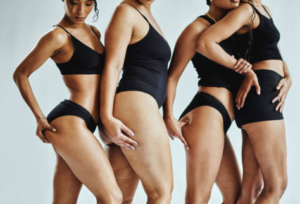Genuine Empowerment or Just Another Marketing Ploy?

In recent years, the body positivity movement has gained significant traction, challenging conventional beauty standards and advocating for the acceptance and celebration of diverse body types. From social media campaigns to advertising campaigns featuring models of all shapes, sizes, and backgrounds, the movement appears to be making strides towards inclusivity and empowerment. However, amid the proliferation of body-positive messaging, questions arise about the movement’s authenticity and its impact on the beauty industry and society as a whole. Is body positivity a genuine empowerment movement, or is it merely another marketing tactic employed by brands to capitalize on consumer sentiments?
The roots of the body positivity movement can be traced back to the 1960s and 1970s, when the feminist movement began challenging traditional gender roles and beauty standards. Early activists, such as the “fat liberation” movement, fought against size discrimination and advocated for acceptance of all body sizes.
However, it wasn’t until the rise of social media in the late 2000s and early 2010s that the body positivity movement gained widespread visibility and momentum. Platforms like Instagram and Tumblr provided a space for individuals to share their stories, experiences, and images celebrating diverse bodies. Influential figures and activists, including bloggers, models, and celebrities, played a significant role in amplifying the message of body positivity and challenging beauty norms.
Core Principles
At its core, the body positivity movement is rooted in several key principles:
- Inclusivity: Body positivity embraces bodies of all shapes, sizes, colors, abilities, and genders. It advocates for representation and visibility of marginalized bodies that have been historically excluded or marginalized in mainstream media and beauty standards.
- Self-Love and Acceptance: Central to the body positivity movement is the promotion of self-love, acceptance, and respect for one’s body. It encourages individuals to reject negative body image and embrace their bodies as they are, recognizing that worth is not determined by appearance.
- Intersectionality: The body positivity movement acknowledges the intersecting identities and experiences that shape individuals’ relationships with their bodies. It recognizes that factors such as race, ethnicity, sexuality, disability, and socioeconomic status intersect with body image and must be addressed in discussions of body positivity.
- Body Autonomy: Body positivity advocates for autonomy over one’s body and choices regarding appearance, including clothing, grooming, and cosmetic enhancements. It rejects the notion that certain bodies are more acceptable or desirable than others and supports individuals in making choices that align with their values and preferences.

The Commercialization of Body Positivity
Despite its noble intentions, the body positivity movement has faced criticism and scrutiny from various quarters. One of the primary critiques is the co-optation of body positivity by mainstream brands and influencers seeking to capitalize on the movement’s popularity. Many argue that these entities exploit body positivity as a marketing tool to sell products and perpetuate consumerism rather than effecting meaningful change. Moreover, some critics contend that the movement has become watered down, focusing more on superficial aspects of body image, such as self-love and confidence, rather than addressing systemic issues such as fatphobia, racism, and ableism.
While the body positivity movement originated as a grassroots effort to challenge narrow beauty standards and promote self-acceptance, it has increasingly become entangled with commercial interests. In recent years, major brands and corporations have capitalized on the movement’s popularity, leveraging it as a marketing tool to sell products and services. This commercialization raises important questions about authenticity, inclusivity, and the movement’s original intentions.
- Co-Opting the Message: Many companies have co-opted the language of body positivity to market their products, often using slogans like “love your body” or “embrace your curves” in their advertising campaigns. While these messages may seem empowering on the surface, they often ring hollow when the same companies continue to promote unrealistic beauty standards through their products and imagery. This disconnect between marketing rhetoric and corporate practices raises concerns about authenticity and sincerity.
- Selective Representation: Another issue with the commercialization of body positivity is the selective representation of bodies in marketing campaigns. While some brands have made efforts to feature diverse models of different sizes, shapes, and ethnicities, others have been accused of tokenism or “performative inclusivity.” In many cases, brands only embrace body positivity when it aligns with their marketing objectives, rather than genuinely championing diversity and representation.
- Exploiting Insecurities: Some critics argue that the commercialization of body positivity perpetuates a cycle of insecurity and consumption. By promoting the idea that self-worth is tied to external appearance, brands can exploit individuals’ insecurities to sell products that promise to “fix” perceived flaws. This focus on external validation can undermine the movement’s message of self-acceptance and empowerment, reinforcing harmful beauty ideals instead.
- Creating Unattainable Standards: The proliferation of beauty products marketed under the guise of body positivity can also contribute to the creation of unattainable standards. From “body sculpting” creams to “cellulite-reducing” treatments, these products often promise unrealistic results, preying on individuals’ desires to conform to societal beauty norms. In doing so, they perpetuate the myth that certain bodies are inherently more desirable than others, undermining the movement’s goal of promoting acceptance and diversity.
- Commodifying Self-Love: One of the most significant criticisms of the commercialization of body positivity is the commodification of self-love. By turning body acceptance into a marketable concept, brands risk trivializing and commodifying a deeply personal and transformative journey. Instead of empowering individuals to embrace their bodies on their own terms, commercialized body positivity can reduce self-love to a transactional exchange, where validation is bought and sold through consumer products.
- Ethical Considerations: The commercialization of body positivity also raises ethical considerations regarding transparency, accountability, and corporate responsibility. Some brands have faced backlash for promoting body positivity while simultaneously engaging in practices that perpetuate body dissatisfaction, such as airbrushing images or promoting unhealthy beauty standards. Consumers are increasingly calling for greater transparency from brands, demanding authenticity and accountability in their marketing practices.
- The Role of Influencers and Social Media: Social media influencers play a significant role in shaping conversations around body positivity, often partnering with brands to promote products and services. While many influencers use their platforms to advocate for body acceptance and diversity, others have been criticized for promoting unrealistic beauty standards or endorsing products that contradict the movement’s principles. As influencers become increasingly entwined with commercial interests, it becomes essential to critically evaluate the authenticity and integrity of their messages.

The Impact on Mental Health
While the body positivity movement aims to uplift individuals and promote self-esteem, its commercialization and superficial focus on self-love can have unintended consequences on mental health. Research indicates that exposure to idealized body images, even those promoting body positivity, can lead to negative body image and increased dissatisfaction among individuals, particularly young women and adolescents.
Moreover, the emphasis on individualistic solutions to body image issues, such as self-affirmations and self-care practices, may overlook the systemic factors that contribute to body dissatisfaction, such as media representation, diet culture, and discrimination. By shifting the focus away from structural change towards individual empowerment, the body positivity movement risks obscuring the broader societal issues that perpetuate body shame and stigma.
In the face of criticism and skepticism, it’s essential to interrogate the authenticity of body positivity efforts and hold brands and influencers accountable for their actions. Authenticity in body positivity requires more than just diverse representation in advertising; it necessitates a commitment to equity, inclusion, and social justice. Brands must demonstrate sincerity in their values and actions by fostering diversity and inclusivity at all levels of their organizations, challenging discriminatory practices, and supporting initiatives that promote body acceptance and diversity.
Furthermore, individuals within the body positivity movement must critically examine their own biases and privileges and strive to create spaces that are truly inclusive and welcoming to all bodies. This means centering the voices and experiences of marginalized communities, advocating for intersectional approaches to body positivity, and challenging internalized biases and prejudices.

Moving Beyond Body Positivity
While the body positivity movement has sparked important conversations about body image and representation, it’s essential to recognize its limitations and work towards more expansive and inclusive approaches to body acceptance. This includes acknowledging the intersecting identities and experiences that shape individuals’ relationships with their bodies, such as race, gender, sexuality, disability, and socio-economic status.
Moreover, we must move beyond the narrow focus on appearance-based self-esteem and embrace a more holistic understanding of well-being that prioritizes mental and physical health, self-compassion, and social connection. This may involve advocating for policies and initiatives that promote body diversity and inclusivity in education, healthcare, and media representation, as well as challenging the pervasive influence of diet culture and weight stigma.
The body positivity movement has undoubtedly brought attention to the importance of embracing diverse bodies and challenging societal beauty norms. However, its commercialization and superficial focus on individual empowerment risk undermining its transformative potential and perpetuating harmful beauty ideals.
To ensure that body positivity remains a genuine empowerment movement, it’s crucial to interrogate the authenticity of efforts within the beauty industry and hold brands and influencers accountable for their actions. Moreover, we must move beyond the narrow confines of body positivity and work towards more expansive and inclusive approaches to body acceptance that address the systemic factors contributing to body shame and stigma.
Ultimately, true empowerment lies in fostering a culture of inclusivity, equity, and self-compassion that celebrates the inherent worth and beauty of every body, regardless of size, shape, or appearance. Only then can we create a world where all individuals feel seen, valued, and accepted for who they are, inside and out.




